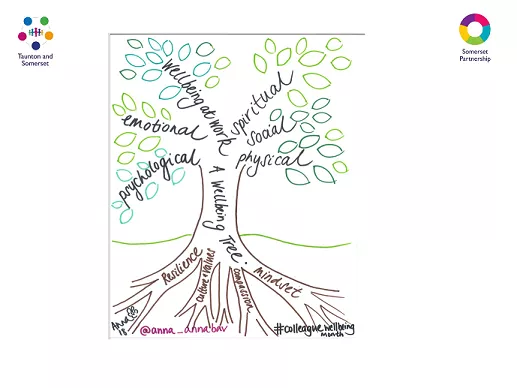
In thinking about how to describe the concept of wellbeing, I have been working on a tree.
The branches divide into fairly well described aspects of wellbeing including: psychological and emotional, physical, social and spiritual. I added a branch wellbeing at work to emphasise the need to prioritise wellbeing at home and work.
Psychological wellbeing is thinking about mental wellbeing and aspects of the mind, clarity of thoughts. Emotional wellbeing is recognising the intense emotions and feelings that we can experience, witness and at times are surrounded by. In combination they are sometimes described as mental health.
Physical wellbeing is often where we start when thinking about wellbeing. The importance for those of us who work long shifts at different times is how we incorporate regular physical exercise, when our jobs can in themselves be exhausting. Access to regular exercise, clubs and team sports can also be challenging.
Spiritual wellbeing for some may be a religion. For me, it also includes the human aspects of caring. ‘The hand to hold,’ the often very tender aspects of compassionate care. How do we ensure we remain spiritually well to enable this?
With social wellbeing, we again often think of activities outside work. However many in healthcare work in teams, so we are often very social at work and have a huge range of interactions with patients, families and colleagues. This in itself brings rewards and challenges.
The wellbeing at work branch is to highlight the importance of thinking about each aspect of wellbeing at work as well as at home. So for example physical wellbeing at work involves looking at work environment, breaks and rest, seating positions and so on. Emotional wellbeing looks at how we support each other and ensure we look after staff so they can continue to deliver high quality, compassionate care. This may include clinical supervision, access to counselling, Balint groups and Schwartz rounds. Psychological wellbeing includes being part of a well-functioning team with good leadership, clear team culture and values. Spiritual wellbeing at work can be recognising the need to take a short break, say a prayer or do a mini mindfulness session. Informal mindful activities can also be useful.
The roots are also very important and lost in some other descriptions of wellbeing. Much is written about resilience. Resilience is an important factor in wellbeing, but is not the only factor. Resilience is a flexible quality that we can improve and develop but that can also get drained and worn down. The BMJ learning module describes resilience as a combination of Confidence, Adaptability, Support and Purpose. Recognising that all these can be nurtured and enhanced enables us to build resilience as individuals and in our teams.
Culture and values are key to us as individuals, but also within our community, society and work environment. We will all have individual values that are important to us personally and professionally. We also have shared professional and team values and wider organisational ones. Our individual cultures are to be celebrated. Diversity has been well described and there is good evidence that nurturing diversity in working environments benefits all.
Compassion for me is where my interest in this started. How can we continue to provide compassionate care, every day, for every patient, while remaining self-compassionate, so we continue to be able to provide compassionate care!
Mindset is also a factor. We all aspire to have a Growth Mindset. With this comes capacity for overcoming challenges, new learning, flexibility and the ability to be open and receptive to feedback. When under pressure many of us retreat to a more fixed mindset.
Finally, I have left a root blank. This is my idea for a wellbeing tree but I hope others will be inspired to draw their own and add to the roots and branches. As we head into winter, let’s spend some time enjoying the season. As the leaves change and fall, I plan to head into some of my favourite woods. I have always felt a sense of awe when surrounded by trees that have stood for many years. The winter for them is a period of rest. They become dormant, slow down their metabolism and conserve energy. They wait out the winter months before getting ready for spring.
Whether gathering some kindling for a fire at the end of a busy week, running admiring the trees in a city park or cycling along a windy ridge aiming for the tree lined shelter…enjoy!










